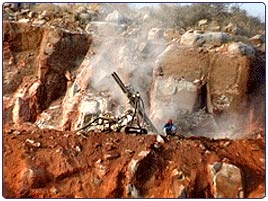Environmental Destruction in Vrindavana
By | Sep 02, 2007

Their hearts full of devotion, hundreds of thousands of pilgrims will stream into Braj Bhoomi around Tuesday for Janmashtami – the birthday of Lord Krishna. But most will turn a blind eye to the poor condition of the sacred area.
Few will talk of the wounds inflicted by environmental degradation, the frenetic construction activity and the eyesores created by the security infrastructure.
Braj Bhoomi is the entire area falling within a 168-mile radius around Mathura that is inseparable from stories about the Cowherd God. It includes Vrindavan and Govardhan Hill.
From Govardhan to Gokul on the other side of Yamuna river, the mood is upbeat and celebration preparations are at their peak level as Janmashtami nears.
In recent years, the Krishna lore with its accent on love and bhakti has drawn hundreds of thousands of new followers who bear all the physical discomforts in the Braj area, many going through 20-km ‘parikramas’ around Govardhan.
It is left to long-timers to notice the effects on the ecology of the area.
‘The thick forest that once enveloped holy Govardhan Hill has disappeared and slowly we find colonies and land developers acquiring land for residential accommodations for pilgrims and retired people,’ laments Manohar Baba, a priest.
The hill is considered sacred by Hindus, as Lord Krishna lifted it on his little finger to protect residents from the ire of rain god Indra.
Social activist Radhakant Shastri said: ‘Besides the spiritual significance, the hill has been central to the maintenance of the ecological balance in the region. There has been a marked shift in the rainfall pattern over the entire area.’
In the by-lanes of Vrindavan, there are heaps of garbage, besides hundreds of widows left to beg for alms.
The barricades and bunkers around the Sri Krishna Janma Bhoomi temple – which stands right next to a mosque – in Mathura and the screening of pilgrims by security personnel are also irritants. Ever since the Babri mosque demolition in 1992, there have been regular threats to the temple.
But devotees take it all in their stride. Many even take the highly polluted Yamuna waters ungrudgingly.
Among the several religious circuits developed by various state governments, the Braj circuit perhaps remains the most neglected and underdeveloped. Land grabbers have annexed every bit of prime property in Mathura, Vrindavan and other smaller towns in the circuit.
The road from the national highway to Vrindavan has imposing edifices by both new age gurus, corporates and film stars.
Construction activity is eating up all the green cover and open spaces in Vrindavan, which has more high-rise buildings and apartments than the district headquarters at Mathura. From actress Hema Malini to religious personality Sadhvi Rithambara to spiritual gurus Kripaluji and Mridulji Maharaj – all have their huge ashrams there.
Environmentalists have also sounded an alarm over the large-scale mining activity going in the area.
The Taj Trapezium Zone, spread over 10,000 sq km, comprising not just Mughal monuments in Agra but also the religious sites of Braj Bhoomi, stands threatened as a result of mining all along the Rajasthan border right from Fatehpur Sikri to Nandgaon, Barsana and Kamavan.
Agra, in fact, used to be part of the 12 forests in the Braj area.
The local administrations in the districts of Mathura, Bharatpur and Agra are helpless as the mining mafia carries on illegal dynamite blasting and quarrying of stones from hills that once formed part of the Krishna folklore.
Environmentalist Raghav Mittal, an Indian Institute of Technology (IIT) alumnus, said this was in total violation of the Rajasthan High Court order.
‘Mining and stone crushing are polluting activities. Large-scale air, water and noise pollution created by these industries is discernible to the naked eye everywhere on the parikrama route,’ Mittal said.
Seventy-year-old saint Ramesh Baba of Barsana said Lord Krishna was the biggest environmentalist — associated as he was with the river Yamuna, peacocks and cattle herds. The god is also said to have been a worshipper of the Goverdhan Hill.
‘It is therefore the duty of his devotees to restore and preserve the ecology of the Braj area,’ the Baba said.














